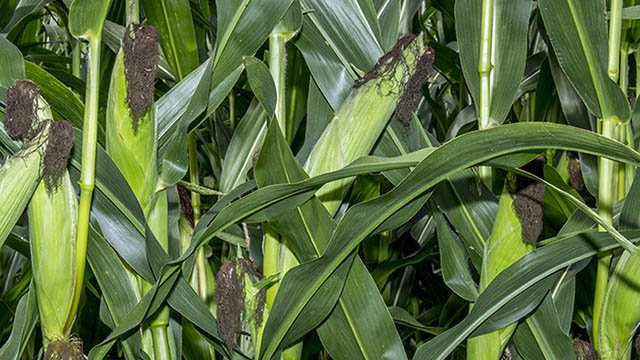Download this list of common corn-based ingredients and products: CORN PRODUCTS & DERIVATIVES.
More than 50 percent of the typical American diet is derived from corn. That is what college grads, Ian Cheney and Curt Ellis, learned when they visited the University of Virginia (UVA) to get a hair sample analysis done by UVA professor of environmental sciences, Stephan Macko. Dr. Macko, a geochemist, pioneered the study of diet from hair. In their feature documentary, King Corn (2007), Cheney and Ellis are shown visiting the lab at the University of Virginia.
Popularity of King Corn, which also aired on PBS in 2008, aroused the curiosity of Diane Sawyer, then host of ABC’s Good Morning America, prompting her to invite professor Macko on the show. Analysis of Ms. Sawyer’s hair was announced on air, and confirmed that fifty percent of the carbon of which she is composed came from corn.
How is it that people who eat a variety of foods can end up with such a high percentage of corn-based carbon? It is not just corn chips and frosted flakes. It is processed foods and meats. Sweeteners, starches, or other ingredients derived from corn are found in nearly all processed foods. And, as shown by isotopic evidence in professor Macko’s analysis, corn travels up the food chain in the meat of corn-fed animals.
In 2016, there were 94 million acres of corn planted in the U.S. Converted to football fields, that would cover more than 71,212,000 football fields including end zones, or an area approximately the size of the State of Montana. Of those 94 million acres of corn, 92% were planted with GMO seed. This corn is field corn, also called yellow dent corn. (Only one percent of corn planted in the U.S. is sweet corn.)
Not quite 40% of corn harvested in 2016 went to feed livestock; almost 30% was used in the production of ethanol. A by-product of ethanol production is the leftover sludge called Dried Distillers Grains (DDGs) which is sold primarily as a component in feed for chickens and hogs.
For a more in depth look at how GMO corn fed animal products could be affecting your health, read Devona Bell’s blog post on the IRT website: Reactions from GM-fed Meat & Animal Products.
It is clear by several measures that Americans’ health has been declining. Although correlation does not prove causation, a huge increase in the incidence and prevalence of disease and chronic health conditions is closely paralleled by the increased use of genetically modified crops and related pesticides. Read more. . .
Recent outrage over soaring prices for the EpiPen, used in schools for emergency treatment of students suffering from severe allergic reactions, has drawn renewed attention to the numbers of children suffering from food allergies. Research from the U.S. Centers for Disease Control and Prevention (CDC) showed that food allergies in children increased by 18% from 1997 to 2007.[i] CDC later reported that the prevalence of food allergy in children increased by 50 percent between 1997 and 2011.[ii] Researchers estimate that up to 15 million Americans have food allergies, including 5.9 million children.[iii]
A corn allergy can be hard to diagnose with standard skin or blood tests because it is difficult to differentiate from allergies to grass pollens and to other seeds and grain. For those who suffer from an acute corn allergy or intolerance to corn gluten, the consequences can be dire. Symptoms of an allergy to corn include:
- Hives or a skin rash
- Nausea, stomach cramps, indigestion, vomiting or diarrhea
- Stuffy or runny nose
- Sneezing
- Headaches
- Asthma
- Anaphylaxis (less common), a potentially life-threatening reaction that impairs breathing and can send the body into shock
The American College of Allergy, Asthma & Immunology notes that published case reports included life-threatening anaphylactic reactions to corn-based products such as a dextrose intravenous solution and cornstarch used to powder surgical gloves.[iv]
Avoiding corn is a tremendous challenge. Iowacorn.org states on their website, that a typical grocery store contains 4,000 items that list corn as an ingredient on the label. Dextrose, maltodextrin, citric acid, xanthan gum, malt syrup, fructose, and modified starch are all derived from corn as are many others on a long list of invisible ingredients. Things you wouldn’t normally think of, like distilled vinegar, are made from corn. Corn-based ingredients are also found in nonfood items like toothpaste and vitamins. Cornstarch, for example can be used both as an adhesive and a coating in paper products, including disposable diapers.
Download this list of common corn-based ingredients and products: CORN PRODUCTS & DERIVATIVES.
[i] Branum, A.M. & Lukacs, S.L. (2008). Food Allergy Among U.S. Children: Trends in Prevalence and Hospitalizations. NCHS Data Brief, No. 10. Retrieved from https://www.cdc.gov/nchs/data/databriefs/db10.pdf
[ii] Jackson KD, Howie LD, Akinbami LJ. Trends in allergic conditions among children: United States, 1997-2011. NCHS data brief, no 121. Hyattsville, MD: National Center for Health Statistics. 2013. Retrieved from http://www.cdc.gov/nchs/products/databriefs/db121.htm.
[iii] Food Allergy Research & Education (2017). Facts and Stats. Retrieved from https://www.foodallergy.org/file/Final-FARE-Food-Allergy-Facts-Statistics.pdf
[iv] American College of Allergy, Asthma & Immuology (2014). Corn Allergy. Retrieved from https://acaai.org/allergies/allergic-conditions/food/
Additional resources.
http://www.kingcorn.net/the-filmmakers/ian-cheney/http://www.kingcorn.net/the-filmmakers/ian-cheney/
http://www.kingcorn.net/the-filmmakers/curt-ellis/
http://uvamagazine.org/articles/the_hair_detective


